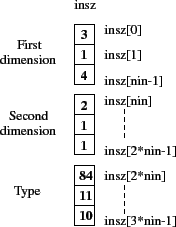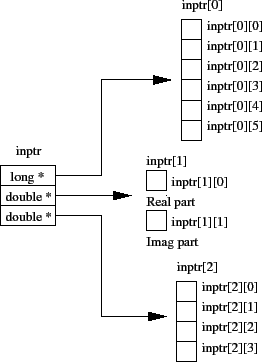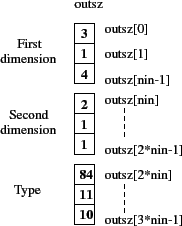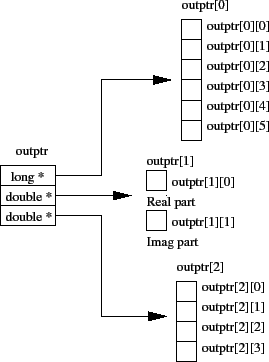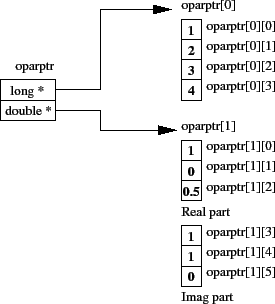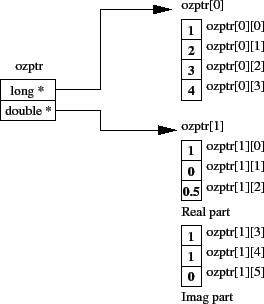The C structure of a Scicos block defines all the fields to handle data provided by the simulator
such inputs/outputs, parameters, states, ...
The fields, that can be either C pointers or directly data, are then accessible via the *block
structure :
- block->nin : Integer that gives the number of regular input ports of the block.
One can't override the index (3*block->nin)-1 when reading sizes of
input ports in the array insz and the index block->nin-1 when reading
data in the array inptr with a C computational function.
The number of regular input ports can also be got by the use of the C macros
GetNin(block).
- block->insz : An array of integers of size 3*nin,1 that respectively gives the first dimensions,
the second dimensions and the type of data driven by regular input ports.
Note that this array of size differs from the array ozsz and oparsz to
provide full compatibilty with blocks that only use a single dimension.
Suppose that you have a block with three inputs : the first is an int32 matrix of
size 3,2, the second a single complex number (matrix of size 1,1) and the last a real
matrix of size 4,1.
In the scicos_model
of such a block, the inputs
will be defined :
model.in = [3;1;4]
model.in2 = [2;1;1]
model.intyp = [2;1;3]
and the corresponding block->insz field at C computational function level will be
coded as :
Do the difference here in the type numbers defined at the Scilab level (2,1,3)
and the type numbers defined at the C level (84,11,10). The following table gives
the correspondance for all Scicos type:
| Scilab Type |
Scilab Number |
C Type |
C Number |
| real |
1 |
double |
10 |
| complex |
2 |
double |
11 |
| int32 |
3 |
long |
84 |
| int16 |
4 |
short |
82 |
| int8 |
5 |
char |
81 |
| uint32 |
6 |
unsigned long |
814 |
| uint16 |
7 |
unsigned short |
812 |
| uint8 |
8 |
unsigned char |
811 |
- block->inptr : An array of pointers of size nin,1 that allow to directly acces to the
data contained in the regular input matrices.
Suppose the previous example (block with three inputs : an int32 matrix of size [3,2],
a complex scalar and a real matrix of size [4,1]).
block->inptr contains three pointers, and should be viewed as arrays contained
the data for the int32, the real and the complex matrices :
For i.e., to directly access to the data, the user can use theses instructions :
#include "scicos_block4.h"
...
SCSINT32_COP *ptr_i;
SCSCOMPLEX_COP *ptr_dc;
SCSREAL_COP *ptr_d;
int n1,m1;
SCSINT32_COP cumsum_i=0;
int i;
...
void mycomputfunc(scicos_block *block,int flag)
{
...
/*get the ptrs of the first int32 regular input port*/
ptr_i = (SCSINT32_COP *) block->inptr[0];
/*get the ptrs of the second complex regular input port*/
ptr_dc = (SCSCOMPLEX_COP *) block->inptr[1];
/*get the ptrs of the third real regular input port*/
ptr_d = (SCSREAL_COP *) block->inptr[2];
...
/*get the dimension of the first int32 regular input port*/
n1=block->insz[0];
m1=block->insz[3];
...
/*compute the cumsum of the input int32 matrix*/
for(i=0;i<n1*m1;i++) {
cumsum_i += ptr_i[i];
}
...
}
One can also use the set of C macros :
GetInPortPtrs(blk,x), GetRealInPortPtrs(block,x),
GetImagInPortPtrs(block,x), Getint8InPortPtrs(block,x),
Getint16InPortPtrs(block,x), Getint32InPortPtrs(block,x),
Getuint8InPortPtrs(block,x), Getuint16InPortPtrs(block,x),
Getuint32InPortPtrs(block,x)
to have the appropiate pointer of the data to handle and
GetNin(block), GetInPortRows(block,x),
GetInPortCols(block,x), GetInPortSize(block,x,y),
GetInType(block,x), GetSizeOfIn(block,x)
to handle number, dimensions and type of regular input ports.
(x is numbered from 1 to nin and y numbered from 1 to 2).
For the previous example that gives :
#include "scicos_block4.h"
...
SCSINT32_COP *ptr_i;
SCSCOMPLEX_COP *ptr_dc;
SCSREAL_COP *ptr_d;
int n1,m1;
SCSINT32_COP cumsum_i=0;
int i;
...
void mycomputfunc(scicos_block *block,int flag)
{
...
/*get the ptrs of the first int32 regular input port*/
ptr_i = Getint32InPortPtrs(block,1);
/*get the ptrs of the second complex regular input port*/
ptr_dc = GetRealInPortPtrs(block,2);
/*get the ptrs of the third real regular input port*/
ptr_d = GetRealInPortPtrs(block,3);
...
/*get the dimension of the first int32 regular input port*/
n1=GetInPortRows(block,1);
m1=GetInPortCols(block,1);
...
}
Finally note that the regular input port registers are only accessible for reading.
- block->nout : Integer that gives the number of regular output ports of the block.
One can't override the index (3*block->nout)-1 when reading sizes of
output ports in the array outsz and the index block->nout-1 when reading
data in the array outptr with a C computational function.
The number of regular output ports can also be got by the use of the C macros
GetNout(block).
- block->outsz : An array of integers of size 3*nout,1 that respectively gives the first dimensions,
the second dimensions and the type of data driven by regular output ports.
Note that this array of size differs from the array ozsz and oparsz to
provide full compatibilty with blocks that only use a single dimension.
Suppose that you have a block with two outputs : the first is an int32 matrix of
size 3,2, the second a single complex number (matrix of size 1,1) and the last a real
matrix of size 4,1.
In the scicos_model
of such a block, the outputs
will be defined :
model.out = [3;1;4]
model.out2 = [2;1;1]
model.outtyp = [2;1;3]
and the corresponding block->outsz field at C computational function level will be
coded as :
Do the difference here in the type numbers defined at the Scilab level (2,1,3)
and the type numbers defined at the C level (84,11,10) and please report to the
previous table to have the correspondence for all Scicos type.
- block->outptr : An array of pointers of size nout,1 that allow to directly acces to the
data contained in the regular output matrices.
Suppose the previous example (block with three outputs : an int32 matrix of size [3,2],
a complex scalar and a real matrix of size [4,1]).
block->outptr contains three pointers, and should be viewed as arrays contained
the data for the int32, the real and the complex matrices :
For i.e., to directly access to the data, the user can use theses instructions :
#include "scicos_block4.h"
...
SCSINT32_COP *ptr_i;
SCSCOMPLEX_COP *ptr_dc;
SCSREAL_COP *ptr_d;
int n1,m1;
SCSINT32_COP cumsum_i=0;
int i;
...
void mycomputfunc(scicos_block *block,int flag)
{
/*get the ptrs of the first int32 regular output port*/
ptr_i = (SCSINT32_COP *) block->outptr[0];
/*get the ptrs of the second complex regular output port*/
ptr_dc = (SCSCOMPLEX_COP *) block->outptr[1];
/*get the ptrs of the third real regular output port*/
ptr_d = (SCSREAL_COP *) block->outptr[2];
...
/*get the dimension of the first int32 regular output port*/
n1=block->outsz[0];
m1=block->outsz[3];
...
/*compute the cumsum of the output int32 matrix*/
for(i=0;i<n1*m1;i++) {
cumsum_i += ptr_i[i];
}
...
}
One can also use the set of C macros :
GetOutPortPtrs(block,x), GetRealOutPortPtrs(block,x),
GetImagOutPortPtrs(block,x), Getint8OutPortPtrs(block,x),
Getint16OutPortPtrs(block,x), Getint32OutPortPtrs(block,x),
Getuint8OutPortPtrs(block,x), Getuint16OutPortPtrs(block,x),
Getuint32OutPortPtrs(block,x)
to have the appropiate pointer of the data to handle and
GetNout(block), GetOutPortRows(block,x),
GetOutPortCols(block,x), GetOutPortSize(block,x,y),
GetOutType(block,x), GetSizeOfOut(block,x)
to handle number, dimensions and type of regular output ports.
(x is numbered from 1 to nout and y is numbered from 1 to 2).
For the previous example that gives :
#include "scicos_block4.h"
...
SCSINT32_COP *ptr_i;
SCSCOMPLEX_COP *ptr_dc;
SCSREAL_COP *ptr_d;
int n1,m1;
SCSINT32_COP cumsum_i=0;
int i;
...
void mycomputfunc(scicos_block *block,int flag)
{
...
/*get the ptrs of the first int32 regular output port*/
ptr_i = GetOutPortPtrs(block,1);
/*get the ptrs of the second complex regular output port*/
ptr_dc = GetRealOutPortPtrs(block,2);
/*get the ptrs of the third real regular output port*/
ptr_d = GetRealOutPortPtrs(block,3);
...
/*get the dimension of the first int32 regular output port*/
n1=GetOutPortRows(block,1);
m1=GetOutPortCols(block,1);
...
}
Finally note that the regular output port registers must be only written for flag=1.
- block->nrpar : Integer that gives the length of the real parameter register.
One can't override the index (block->nrpar)-1 when reading value of real
parameters in the register rpar.
The total number of real parameters can also be got by the use of the C macro
GetNrpar(block).
- block->rpar : Array of double of size nrpar,1 corresponding to the real parameter register. That register
is used to pass real parameters coming from the scilab/scicos environment to your block
model.
The C type of that array is double * (or C scicos type SCSREAL_COP *).
Suppose that you have defined the following real parameters in the
scicos_model
of a block :
model.rpar = [%pi;%pi/2;%pi/4]
you can retrieve the previous data in the C computational function with :
#include "scicos_block4.h"
...
double PI;
double PI_2;
double PI_4;
...
void mycomputfunc(scicos_block *block,int flag)
{
...
/*get the first value of the real param register*/
PI = block->rpar[0];
/*get the second value of the real param register*/
PI_2 = block->rpar[1];
/*get the third value of the real param register*/
PI_4 = block->rpar[2];
...
}
You can also use the C macro GetRparPtrs(block) to get the pointer of the
real parameter register. For i.e., if we define the following
scicos_model
in an interfacing function of a
scicos block :
A = [1.3 ; 4.5 ; 7.9 ; 9.8];
B = [0.1 ; 0.98];
model.rpar = [A;B]
in the corresponding C computational function of that block, we'll use :
#include "scicos_block4.h"
...
double *rpar;
double *A;
double *B;
...
void mycomputfunc(scicos_block *block,int flag)
{
...
/*get ptrs of the real param register*/
rpar = GetRparPtrs(block);
/*get the A ptrs array*/
A = rpar;
/*get the B ptrs array*/
B = &rpar[4];
/*or B = rpar + 4;*/
...
}
Note that real parameters register is only accessible for reading.
- block->nipar : Integer that gives the length of the integer parameter register.
One can't override the index (block->nipar)-1 when reading value of integer
parameters in the register ipar.
The total number of integer parameters can also be got by the use of the C macro
GetNipar(block).
- block->ipar : Array of int of size nipar,1 corresponding to the integer parameter register. That register
is used to pass integer parameters coming from the scilab/scicos environment to your block
model.
The C type of that array is int * (or C scicos type SCSINT_COP *).
Suppose that you have defined the following integer parameters in the
scicos_model
of a block :
model.ipar = [(1:3)';5]
you can retrieve the previous data in the C computational function with :
#include "scicos_block4.h"
...
int one;
int two;
int three;
int five;
...
void mycomputfunc(scicos_block *block,int flag)
{
...
/*get the first value of the integer param register*/
one = block->ipar[0];
/*get the second value of the integer param register*/
two = block->ipar[1];
/*get the third value of the integer param register*/
three = block->ipar[2];
/*get the fourth value of the integer param register*/
five = block->ipar[3];
...
}
You can also use the C macro GetIparPtrs(block) to get the pointer of the
real parameter register.
Most of time in the scicos C block libraries, the integer register is used to
parametrize the length of real parameters. For i.e. if you define the following
scicos_model
in a block :
// set a random size for the first real parameters
A_sz = int(rand(10)*10);
// set a random size for the second real parameters
B_sz = int(rand(10)*10);
// set the first real parameters
A = rand(A_sz,1,``uniform'');
// set the second real parameters
B = rand(B_sz,1,``normal'');
// set ipar
model.ipar = [A_sz;B_sz]
// set rpar (length of A_sz+B_sz)
model.rpar = [A;B]
the array of real parameters (parametrized by ipar) can be retrieved in the
correspondig C computational function with :
#include "scicos_block4.h"
...
int A_sz;
int B_sz;
double *rpar;
double *A;
double *B;
double cumsum;
int i;
...
void mycomputfunc(scicos_block *block,int flag)
{
...
/*get ptrs of the real param register*/
rpar = GetRparPtrs(block);
/*get size of the first real param register*/
A_sz = block->ipar[0];
/*get size of the second real param register*/
B_sz = block->ipar[1];
/*get the A ptrs array*/
A = rpar;
/*get the B ptrs array*/
B = &rpar[A_sz];
...
/*compute the cumsum of the first real parameter array*/
cumsum = 0;
for(i=0;i<A_sz;i++) {
cumsum += A[i];
}
...
/*compute the cumsum of the second real parameter array*/
cumsum = 0;
for(i=0;i<B_sz;i++) {
cumsum += B[i];
}
Note that integer parameters register is only accessible for reading.
- block->nopar : Integer that gives the number of the object parameters.
One can't override the index block->nopar-1 when accessing data in the arrays
oparsz, opartyp and oparptr in a C computational function.
This value is also accessible via the C macro GetNopar(block).
- block->oparsz : An array of integer of size nopar,2 that contains the dimensions of matrices of
object parameters.
The first column is for the first dimension and the second for the second dimension.
For i.e. if we want the dimensions of the last object parameters, we'll use the instructions :
#include "scicos_block4.h"
...
int nopar;
int n,m;
...
void mycomputfunc(scicos_block *block,int flag)
{
...
/*get the number of object parameter*/
nopar=block>nopar;
...
/*get number of row of the last object parameter*/
n=block>oparsz[nopar-1];
/*get number of column of the last object parameter*/
m=block>oparsz[2*nopar-1];
...
}
The dimensions of object parameters can be get with the following C macro :
GetOparSize(block,x,1); /*get first dimension of opar*/
GetOparSize(block,x,2); /*get second dimension of opar*/
with x an integer that gives the index of the object parameter, numbered
from 1 to nopar.
- block->opartyp : An array of integer of size nopar,1 that contains the type of matrices of
object parameters.
The following table gives the correspondence for scicos type expressed in Scilab number,
in C number and also corresponding C pointers and C macros used for oparptr :
| Scilab |
|
C |
|
|
| Type |
Number |
Number |
Type |
Macros |
| real matrix |
1 |
10 |
double |
SCSREAL_COP |
| complex matrix |
2 |
11 |
double |
SCSCOMPLEX_COP |
| int32 matrix |
3 |
84 |
long int |
SCSINT32_COP |
| int16 matrix |
4 |
82 |
short |
SCSINT16_COP |
| int8 matrix |
5 |
81 |
char |
SCSINT8_COP |
| uint32 matrix |
6 |
814 |
unsigned long int |
SCSUINT32_COP |
| uint16 matrix |
7 |
812 |
unsigned short |
SCSUNINT16_COP |
| uint8 matrix |
8 |
811 |
unsigned char |
SCSUINT8_COP |
| all others data |
|
-1 |
double |
SCSUNKNOWN_COP |
The type of object parameter can also be got by the use of the C macro
GetOparType(block,x). For i.e, if we want the C number type of the first
object parameter, we'll use the following C instructions:
#include "scicos_block4.h"
...
int opartyp_1;
...
void mycomputfunc(scicos_block *block,int flag)
{
...
/*get the number type of the first object parameter*/
opartyp_1 = GetOparType(block,1);
...
}
- block->oparptr : An array of pointers of size nopar,1 that allow to directly acces to the
data contained in the object parameter.
Suppose that you have defined in the editor a block with the following
opar field in scicos_model
:
model.opar=list(int32([1,2;3,4]),[1+%i %i 0.5]);
Then we have two object parameters, one is an 32-bit integer matrix with two rows and two
columns and the second is a vector of complex numbers that can be understand as a matrix
of size 1,3.
At the C computational function level, the instructions block->oparsz[0],
block->oparsz[1], block->oparsz[2], block->oparsz[3] will respectively return the
values 2,1,2,3 and the instructions block->opartyp[0], block->opartyp[1] the values 11 and
84.
block->oparptr will contain then two pointers, and should be viewed as arrays contained data of
object parameter as shown in the following figure :
For i.e., to directly access to the data, the user can use theses instructions :
#include "scicos_block4.h"
...
SCSINT32_COP *ptr_i;
SCSINT32_COP cumsum_i;
SCSCOMPLEX_COP *ptr_d;
SCSREAL_COP cumsum_d;
...
void mycomputfunc(scicos_block *block,int flag)
{
...
/*get the ptrs of an int32 object parameter*/
ptr_i = (SCSINT32_COP *) block->oparptr[0];
/*get the ptrs of a double object parameter*/
ptr_d = (SCSCOMPLEX_COP *) block->oparptr[1];
...
/*compute the cumsum of the int32 matrix*/
cumsum_i = ptr_i[0]+ptr_i[1]+ptr_i[2]+ptr_i[3];
...
/*compute the cumsum of the real part of the complex matrix*/
cumsum_d = ptr_d[0]+ptr_d[1]+ptr_d[2];
...
}
One can also use the set of C macros :
GetRealOparPtrs(block,x), GetImagOparPtrs(block,x),
Getint8OparPtrs(block,x), Getint16OparPtrs(block,x),
Getint32OparPtrs(block,x), Getuint8OparPtrs(block,x),
Getuint16OparPtrs(block,x), Getuint32OparPtrs(block,x)
to have the appropiate pointer of the data to handle (x is numbered from 1 to nopar).
For the previous example that gives :
#include "scicos_block4.h"
...
SCSINT32_COP *ptr_i;
SCSREAL_COP *ptr_dr;
SCSREAL_COP *ptr_di;
...
void mycomputfunc(scicos_block *block,int flag)
{
...
/*get the ptrs of an int32 object parameter*/
ptr_i = Getint32OparPtrs(block,1);
/*get the ptrs of a double object parameter*/
ptr_dr = GetRealOparPtrs(block,2);
ptr_di = GetImagOparPtrs(block,2);
...
}
Note that object parameters register is only accessible for reading.
- block->nx : Integer that gives the length of the continus state register.
One can't override the index block->nx-1 when reading or writing data in
the array x, xd or res with a C computational function.
- block->x : Array of double of size nx,1 corresponding to the continuous state register.
That gives the result of the computation of the state derivative.
A value of a continuous state is readable (for i.e the first state) with
the C instructions :
#include "scicos_block4.h"
...
double x_1;
...
void mycomputfunc(scicos_block *block,int flag)
{
...
x_1=block->x[0];
...
}
Note that on flag=4, user can write some initial conditions in that register.
The pointer of that array can also be retrieve via the C macro GetState(block).
- block->xd : Array of double of size nx,1 corresponding to the derivative of the continuous state register.
When systems are explicitly given in terms of Ordinary Differential Equations (ODE), it can be
explicitly expressed or implicitly used in the residual vector res when systems are expressed
in terms of Differantial Algebraic Equations (DAE).
Both systems must be programmed with flag= 0.
For i.e the Lorentz attractor written as an ODE system with three state variables, of the form :
will be defined :
#include "scicos_block4.h"
...
double *x = block->x;
double *xd = block->xd;
...
/* define parameters */
double a = 10;
double b = 28;
double c = 8/3;
...
void mycomputfunc(scicos_block *block,int flag)
{
...
if (flag == 0) {
xd[0] = a*(x[1]-x[0]);
xd[1] = x[1]*(b-x[2])-x[1];
xd[2] = x[0]*x[1]-c*x[2];
}
...
}
- block->res : Array of double of size nx,1 corresponding to Differential Algebraic Equation (DAE) residual.
It is used to write the vector of systems that have the following form :
For i.e the Lorentz attractor written as a DAE system with three state variables, will be defined :
#include "scicos_block4.h"
...
double *x = block->x;
double *xd = block->xd;
double *res = block->res;
...
/* define parameters */
double a = 10;
double b = 28;
double c = 8/3;
...
void mycomputfunc(scicos_block *block,int flag)
{
...
if (flag == 0) {
res[0] = - xd[0] + (a*(x[1]-x[0]));
res[1] = - xd[1] + (x[0]*(b-x[2])-x[1]);
res[2] = - xd[2] + (x[0]*x[1]-c*x[2]);
}
...
}
- block->nz : Integer that gives the length of the discrete state register.
One can't override the index block->nz-1 when reading data in the array z
with a C computational function.
This value is also accessible via the C macros GetNdstate(block).
- block->z : Array of double of size nz,1 corresponding to the discrete state register.
A value of a discrete state is directly readable (for i.e the second state) with
the C instructions :
#include "scicos_block4.h"
...
double z_2;
...
void mycomputfunc(scicos_block *block,int flag)
{
...
z_2=block->z[1];
...
}
Note that the state register should be only written for flag=4 and flag=2.
The pointer of that array can also be retrieve via the C macro GetDstate(block).
- block->noz : Integer that gives the number of the discrete object states.
One can't override the index block->noz-1 when accessing data in the arrays
ozsz, oztyp and ozptr in a C computational function.
This value is also accessible via the C macro GetNoz(block).
- block->ozsz : An array of integer of size noz,2 that contains the dimensions of matrices of
discrete object states.
The first column is for the first dimension and the second for the second dimension.
For i.e. if we want the dimensions of the last object state, we'll use the instructions :
#include "scicos_block4.h"
...
int noz;
int n,m;
...
/*get the number of object state*/
noz=block>noz;
...
void mycomputfunc(scicos_block *block,int flag)
{
...
/*get number of row of the last object state*/
n=block>ozsz[noz-1];
/*get number of column of the last object state*/
m=block>ozsz[2*noz-1];
...
}
The dimensions of object discrete states can be get with the following C macro :
GetOzSize(block,x,1); /*get first dimension of oz*/
GetOzSize(block,x,2); /*get second dimension of oz*/
with x an integer that gives the index of the discrete object state, numbered
from 1 to noz.
- block->oztyp : An array of integer of size noz,1 that contains the type of matrices of
discrete object states.
The following table gives the correspondence table for scicos type expressed in Scilab number,
in C number and also corresponding C pointers and C macros used for ozptr :
| Scilab |
|
C |
|
|
| Type |
Number |
Number |
Type |
Macros |
| real matrix |
1 |
10 |
double |
SCSREAL_COP |
| complex matrix |
2 |
11 |
double |
SCSCOMPLEX_COP |
| int32 matrix |
3 |
84 |
long int |
SCSINT32_COP |
| int16 matrix |
4 |
82 |
short |
SCSINT16_COP |
| int8 matrix |
5 |
81 |
char |
SCSINT8_COP |
| uint32 matrix |
6 |
814 |
unsigned long int |
SCSUINT32_COP |
| uint16 matrix |
7 |
812 |
unsigned short |
SCSUNINT16_COP |
| uint8 matrix |
8 |
811 |
unsigned char |
SCSUINT8_COP |
| all others data |
|
-1 |
double |
SCSUNKNOWN_COP |
The type of discrete object state can also be got by the use of the C macro
GetOzType(block,x). For i.e, if we want the C number type of the first
discrete object state, we'll use the following C instructions:
#include "scicos_block4.h"
...
int oztyp_1;
...
void mycomputfunc(scicos_block *block,int flag)
{
...
/*get the number type of the first object state*/
oztyp_1 = GetOzType(block,1);
...
}
- block->ozptr : An array of pointers of size noz,1 that allow to directly acces to the
data contained in the discrete object state.
Suppose that you have defined in the editor a block with the following
odstate field in scicos_model
:
model.odstate=list(int32([1,2;3,4]),[1+%i %i 0.5]);
Then we have two discrete object states, one is an 32-bit integer matrix with two rows and two
columns and the second is a vector of complex numbers that can be understand as a matrix
of size 1,3.
At the C computational function level, the instructions block->ozsz[0],
block->ozsz[1], block->ozsz[2], block->ozsz[3] will respectively return the
values 2,1,2,3 and the instructions block->oztyp[0], block->oztyp[1] the values 11 and
84.
block->ozptr will contain then two pointers, and should be viewed as arrays contained data of
discrete object state as shown in the following figure :
For i.e., to directly access to the data, the user can use theses instructions :
#include "scicos_block4.h"
...
SCSINT32_COP *ptr_i;
SCSINT32_COP cumsum_i;
SCSCOMPLEX_COP *ptr_d;
SCSREAL_COP cumsum_d;
...
void mycomputfunc(scicos_block *block,int flag)
{
...
/*get the ptrs of an int32 discrete object state*/
ptr_i = (SCSINT32_COP *) block->ozptr[0];
/*get the ptrs of a double discrete object state*/
ptr_d = (SCSCOMPLEX_COP *) block->ozptr[1];
...
/*compute the cumsum of the int32 matrix*/
cumsum_i = ptr_i[0]+ptr_i[1]+ptr_i[2]+ptr_i[3];
...
/*compute the cumsum of the real part of the complex matrix*/
cumsum_d = ptr_d[0]+ptr_d[1]+ptr_d[2];
...
}
One can also use the set of C macros :
GetRealOzPtrs(block,x), GetImagOzPtrs(block,x),
Getint8OzPtrs(block,x), Getint16OzPtrs(block,x),
Getint32OzPtrs(block,x), Getuint8OzPtrs(block,x),
Getuint16OzPtrs(block,x), Getuint32OzPtrs(block,x)
to have the appropiate pointer of the data to handle (x is numbered from 1 to noz).
For the previous example that gives :
#include "scicos_block4.h"
...
SCSINT32_COP *ptr_i;
SCSREAL_COP *ptr_dr;
SCSREAL_COP *ptr_di;
...
void mycomputfunc(scicos_block *block,int flag)
{
...
/*get the ptrs of an int32 discrete object state*/
ptr_i = Getint32OzPtrs(block,1);
/*get the ptrs of a double discrete object state*/
ptr_dr = GetRealOzPtrs(block,2);
ptr_di = GetImagOzPtrs(block,2);
...
}
Finally note that the discrete objects state should be only written for flag=4 and flag=2.
- block->work : A free pointer to set a working array for the block.
The work pointer must be firstly allocated when flag = 4 and finally be free in the
flag = 5.
Then a basic life cyle of that pointer in a C computational function should be :
#include "scicos_block4.h"
...
void** work=block->work;
...
void mycomputfunc(scicos_block *block,int flag)
{
...
/*initialization*/
if (flag==4) {
/*allocation of work*/
if (*work=scicos_malloc(sizeof(double))==NULL) {
set_block_error(-16);
return;
}
...
}
...
/*other flag treatment*/
...
/*finish*/
else if (flag==5) {
scicos_free(*work);
}
...
}
Note that if a block use a work pointer, it will be called with flag=2 even if
the block don't use discrete states.
The pointer of that array can also be retrieve via the C macro GetWorkPtrs(block).
